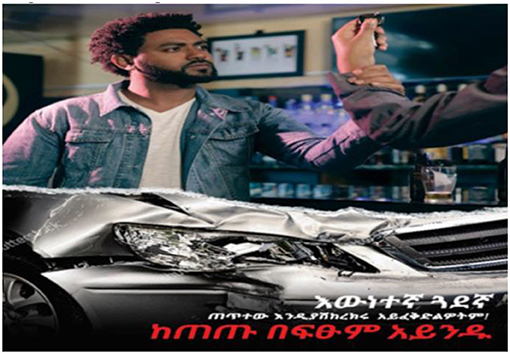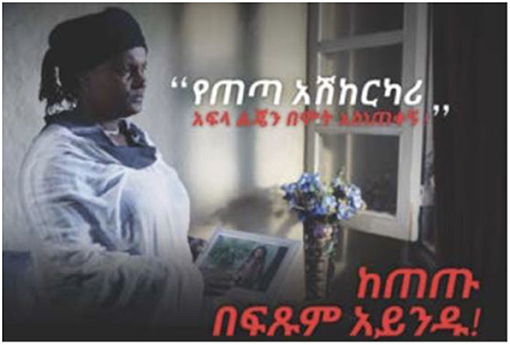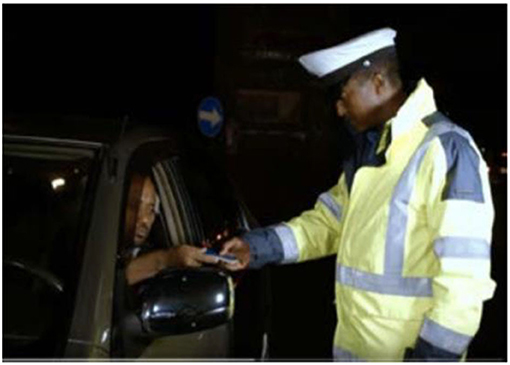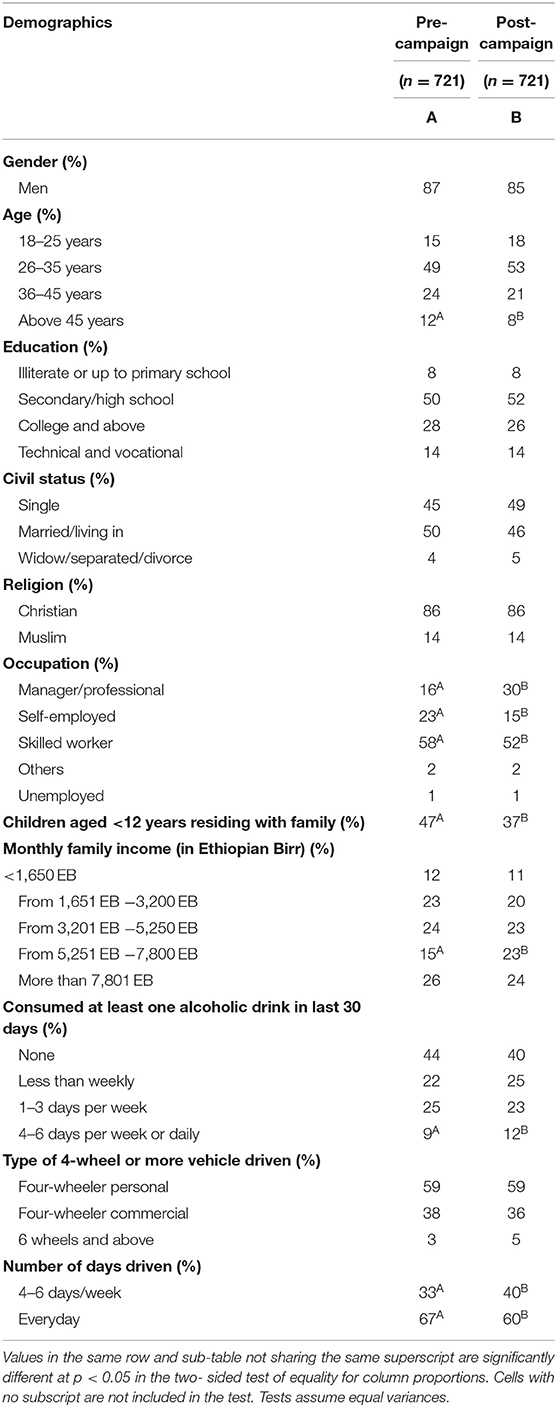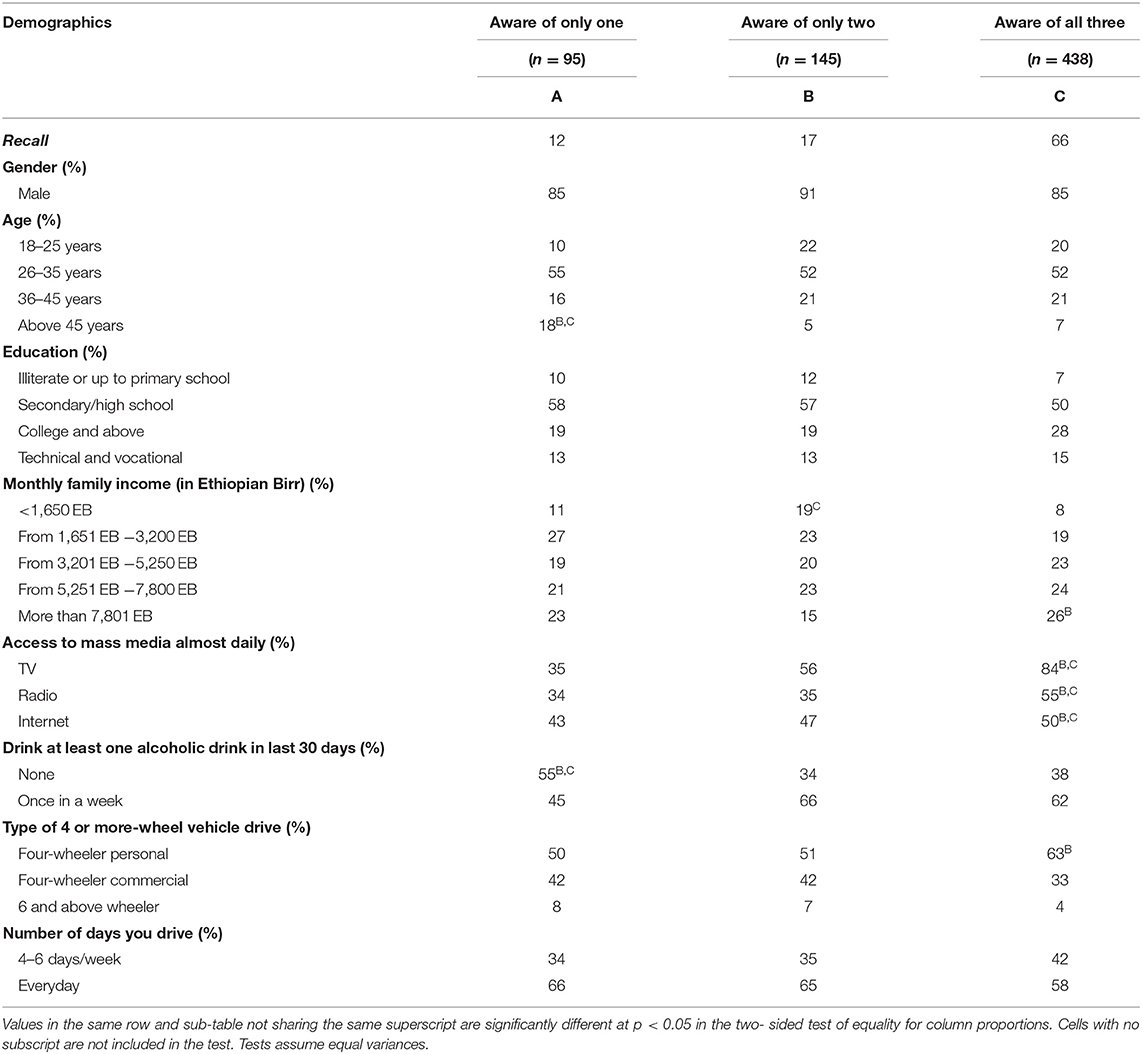Effectiveness of a Drinking and Driving Campaign on Knowledge, Attitudes, and Behavior Among Drivers in Addis Ababa
- 1Vital Strategies, New York, NY, United States
- 2Sub Saharan Africa Research and Training Center, Addis Ababa, Ethiopia
- 3Economic Cluster Coordinator of Addis Ababa City Administration, Addis Ababa, Ethiopia
- 4Bloomberg Philanthropies Initiative for Global Road Safety, Addis Ababa, Ethiopia
Background: In Addis Ababa, Ethiopia, road traffic crashes represent a major public health challenge. Driving under the influence of alcohol (drink driving) is a risk factor for road traffic crashes. Mass media campaigns can reduce the prevalence of drink driving. Few studies to date have evaluated the influence of anti-drink-driving campaigns on changes in knowledge, attitudes, and behaviors in low-income countries such as Ethiopia.
Objective: This study aims to examine the impact of an anti-drink-driving campaign on knowledge, attitudes, and behaviors around drinking and driving in Addis Ababa, Ethiopia.
Methods: The “Never Drink and Drive” campaign ran on media outlets in Addis Ababa and consisted of evidence-informed messages on the consequences of drink driving. Data for this study comes from two representative household surveys conducted among a sample of adult drivers aged 18–55 years in Addis Ababa pre-campaign (n = 721) and post-campaign (n = 721). Multivariate logistic regression is used to estimate the effects of the campaign on knowledge, attitudes, and behavior related to drink driving.
Results: After the campaign, participants were significantly more likely to have improved knowledge and attitudes about drink driving: post-campaign participants were significantly more likely to report feeling unsafe about drink driving (OR = 1.51, p < 0.05). Social norms showed a positive shift: post-campaign participants were over six and a half times more likely to report that someone talked to them about drink driving (OR = 6.52, p < 0.05). After the campaign, participants demonstrated improved knowledge and attitudes around drink driving laws and enforcement, including that they were significantly more likely to agree that they would be caught by police for drink driving (OR = 12.66, p < 0.1). Behavior also improved—post-campaign participants reported significantly lower rates of driving soon after drinking alcohol, compared with pre-campaign participants (31 vs. 42%).
Conclusion: The anti-drink-driving campaign achieved gains in knowledge, improved attitudes, and reduced drinking and driving, which could help to curb road traffic crashes in Addis Ababa. This study offers some of the first evidence that an anti-drink-driving campaign, combined with enhanced enforcement of road safety laws, can be effective in changing knowledge, attitudes, and behaviors around drink driving in low-income countries.
Introduction
Road traffic crashes are the eighth leading cause of death globally and a major public health challenge that needs to be addressed. Every year, ~1.35 million people die as a result of road traffic crashes and as many as 50 million others suffer from non-fatal injuries that may lead to disability (World Health Organization, 2018). In many countries around the world, road traffic crashes are not only a major cause of mortality, morbidity, and serious injuries but also impose financial burdens on families and society (Decker et al., 1988; Kenkel, 1993). In low-income countries, the risk of road traffic deaths is three times higher compared to high-income countries, with the greatest burden in the African region (World Health Organization, 2018). Road traffic crashes in Ethiopia have been rising along with rapid motorization, a lack of regulation of motor vehicles, and population growth. In Ethiopia, the road crash fatality rate for 2016 was estimated at 26.7 per 100,000 population, compared to 18.2 globally and 26.6 for the African region (World Health Organization, 2018).
Driving under the influence of alcohol (drink driving) is one of the major risk factors for road traffic crashes (Agent et al., 2002). The consumption of alcohol—even in relatively small amounts—affects drivers' judgement, vision, coordination, and reflexes and increases the risk of having a crash (Carvajal and Lerma-Cabrera, 2015; Pan American Health Organization World Health Organization, 2018). Even among professional drivers, there is a high prevalence of drink driving and poor self-reported road safety outcomes, road traffic fines, and crashes, regardless of the regularity or frequency of alcohol consumption (Useche et al., 2017). In addition, driving under the influence of alcohol leads to other high-risk road use behaviors, such as speeding, that can harm other road users who may be following traffic laws (Zhao et al., 2014; World Health Organization, 2018; Yadav et al., 2019). Finally, drivers with alcohol use disorders are more likely to be disqualified from driving as a result of road safety offenses, including crash involvement and traffic violations that lead to demerit points and/or loss of a driver's license (Martí-Belda et al., 2019).
While progress has been made in reducing alcohol-impaired driving crashes in many high-income countries, low-income countries face particular challenges in reducing drink driving, including social and cultural norms of alcohol use, lack of reliable traffic safety data, and lack of well-developed drink driving policies (Stewart et al., 2012). In Addis Ababa, road traffic crashes, and injuries represent a major public health challenge (Addis Ababa City Administration, 2017a). In 2013, Addis Ababa recorded 382 reported road fatalities, and from 2012 to 2014, the city recorded ~12.5% of all reported road fatalities in Ethiopia (Addis Ababa City Administration, 2017a). Among adult deaths due to injury, road traffic crash was the most common cause with an increasing trend in Addis Ababa (Anteneh and Endris, 2020). Drink driving is an important factor contributing to the city's road safety crisis (Addis Ababa City Administration, 2017a). From September 2013 to August 2014, analysis of road traffic crash data in Addis Ababa suggest that over half of fatal road traffic crashes are due to “reckless driving behavior” (53.8%) and <1% are due to drink or drugged driving (0.6%) (Kebede et al., 2019). However, other studies have suggested that the prevalence of drink driving cases is as high as 9% and drink driving is significantly associated with road traffic crash injury and death in Addis Ababa (Mekonen, 2016; Bekele and Sima, 2019; John's Hopkins University, 2019).
Mass media campaigns are an effective public health intervention for addressing social norms and changing health behaviors (Redman et al., 1990; Noar, 2006; Wakefield et al., 2010). For mass media campaigns to be effective, they must not only impart crucial health information, such as through the presentation of facts or figures, but also persuade through the use of emotional appeals, such as through evocative stories and images (Elliott, 1993; Ulleberg et al., 2009). In the context of road safety, evidence-based campaigns have been found to increase knowledge and change attitudes, leading to reductions in risky road behaviors (Redman et al., 1990; Tay, 2002). Campaigns to reduce alcohol-impaired driving that persuade individuals to not drink and drive and encourage them to prevent others from doing so; spreading messages about the physical dangers and legal consequences of drink driving also tends to be effective (Elder et al., 2004; Phillips et al., 2011; Young et al., 2018). Campaigns with concomitant activities for reducing alcohol-impaired driving, such as legislation and enforcement efforts against alcohol-impaired driving, are also beneficial for reducing road traffic crashes (Elvik et al., 2004; Phillips et al., 2011; Bachani et al., 2017).
Many countries around the world use the tripartite model of legislation-enforcement-advertising for effective campaigns against drink driving (Cheng et al., 2011). In high-income countries, campaigns, when coupled with legislation and enforcement of legislation, are an evidence-based public health tool that can reduce drink driving (Lastovicka et al., 1990; Redman et al., 1990; Murry et al., 1993; Mruk, 2007; Young et al., 2018). However, there is a dearth of literature on this topic from low- and middle-income countries. More studies from low- and middle-income countries are needed, as this is where the majority of road traffic crash deaths occur. Also, it is important to examine the impact of anti-drink-driving campaigns on drinking and driving in these countries because results from studies in high-income countries may not be generalizable to low- and middle-income countries where traffic regulations and driving practices might be different. To our knowledge, no study has assessed the impact of anti-drink-driving campaigns in terms of knowledge, attitudes, and behaviors in low- and middle-income countries, such as Ethiopia. This study aims to address this gap by examining the impact of an anti-drink-driving campaign on knowledge, attitudes, and behaviors around drinking and driving in Addis Ababa.
The drinking and driving campaign in Addis Ababa was developed through a partnership between the Addis Ababa Transport Programs Management Office and Vital Strategies as part of the Bloomberg Philanthropies Initiative for Global Road Safety (BIGRS). This multi-partner program focused on reducing four risky road user behaviors: speeding, lack of seatbelt wearing, lack of helmet wearing, and drink driving. This campaign, coupled with police training on drink driving enforcement and the provision of breathalyzers and other critical equipment, was initiated based on results from an observational study in 2015 showing a high rate of drinking and driving in the city (as cited in Addis Ababa City Administration, 2017a).
Materials and Methods
Study Design
This study uses a quasi-experimental design. In this intervention study, pre- and post- indices are assessed to evaluate the effect of a mass media campaign aimed at reducing the burden of drink driving, which contributes to road traffic crashes in Addis Ababa. To evaluate the campaign's impact, representative household surveys of adults based in Addis Ababa were conducted just prior to the launch of the campaign and immediately following its conclusion. Both surveys were conducted by the Sub Saharan Africa Research and Training Center (known as SART Consult), a research agency based in Addis Ababa, with the pre-campaign (or baseline) survey conducted from September 9 to September 18, 2016 and the post-campaign survey conducted from April 28 to May 5, 2017.
Addis Ababa Government's Drink Driving Campaign
The Addis Ababa Transport Programs Management Office, in partnership with Vital Strategies, established the “Never Drink and Drive” campaign aimed to curb road traffic crash deaths and injuries that result from drink driving. Along with the mass media campaign, there were concomitant enforcement activities by traffic police on drinking and driving during the campaign period.
The campaign (see Appendix A in Supplementary Material) consisted of three message-tested public service announcements (PSAs) that use an emotional appeal, including storytelling, to communicate messages focused on the health, social, and legal consequences of drinking and driving. The first PSA, “Celebrate,” depicts two friends at a bar; one tries to prevent the other from driving because he had been drinking alcohol, but the man laughs off his friend's concerns and drives home, and subsequently dies in a crash on his way home (see Figure 1). The first PSA communicates the message that, although a driver may believe they can drive safely after drinking, even a small amount of alcohol can make driving unsafe. The second PSA, “Testimonial,” shows a grief-stricken mother whose daughter, a promising university student, died in a road traffic crash in which a driver had been drinking alcohol (see Figure 2). The second PSA communicates the impact of drinking and driving on families and the community. The third PSA, “Enforcement,” shows real police officers using breathalyzers to check drivers' alcohol levels—deemed important as breathalyzers had not been used in Addis Ababa before—and includes an explanation of the legal limit for alcohol for drivers (see Figure 3). The third PSA communicates an enforcement message to increase driver perceptions of their risk of being caught and punished if they break the law.
The campaign ran on multiple mass media outlets, including radio, television, billboards and posters, and on social media. The three advertisements were staggered in phases within the campaign, with “Celebrate” and “Testimonial” on air from October 18 to December 9, 2016 and again from April 6 to 21, 2017. “Enforcement” aired from March 29 to April 5, 2017 (Addis Ababa City Administration, 2017b). A total of 150 television exposures and 508 radio spots were purchased, including airings after the national television news on all weekdays. The spots were also aired 180 times total in two major cinemas and 1,800 times on an outdoor screen at a cinema complex. The campaign dates were synchronized with police enforcement activities around drink driving. Notably, this period marked the first time Addis Ababa police had used breathalyzers for systematic enforcement of drinking and driving.
Sampling Method and Sample Size
A multistage stratified random sampling procedure was used to recruit participants for the surveys. The 2007 census was used as a sampling frame. Census enumeration areas for urban and peri-urban areas formed the primary sampling units. There were a total of 3,779 enumeration areas in Addis Ababa (Census of Ethiopia, 2007), distributed across all 10 sub-cities; 17 enumeration areas were selected across the 10 sub-cities, with one to three in each sub-city based on the population size. Census enumeration areas were selected at random, then households were selected from within these areas, and then participants selected from within these households. A Kish grid was used to select one participant from among multiple eligible participants in a household.
The study participants were current residents of Addis Ababa who were aged 18–55 years. The study selected participants who were current drivers of vehicles with four or more wheels (e.g., car, van, bus, or truck) and drove these vehicles frequently (four or more days a week). People were excluded from the study if, at the time of data collection, they worked in road safety (including traffic departments, non-governmental organizations that work in road safety, etc.); advertising; market research; or the alcohol, tobacco, or automobile industries. A total of 1,442 drivers were interviewed (721 each in the pre- and post-campaign surveys). These cross-sectional samples are used for this study. For details on the sampling procedure and sample size, see Appendixes B,C in the Supplementary Material.
Measures
The data gathered in the study were quantitative and collected using close-ended questions. A few questions, such as those related to reactions to the campaign, attitudes, enforcement of drinking and driving laws, interpersonal communication, and support for the road safety campaign, were asked based on a five-point Likert scale. The following were key measures in the study (for details, see Appendix D in Supplementary Material).
Campaign Awareness
Campaign awareness was assessed by showing participants images from each of the campaign PSAs (television, outdoors, and social media) and reading them a few sentences from the radio advertisement. Next, participants were asked what messages they recalled from the campaign. This was repeated for all three PSAs. All those who recognized any one of the campaign's three PSAs accurately (that is, they recognized any one of the campaign images or the radio script and they accurately recalled the campaign message) were categorized as “campaign aware.” All other participants were categorized as “campaign unaware.”
Reactions to the Campaign
Reactions to the campaign were assessed by asking campaign-aware participants how strongly they agreed or disagreed with a series of statements about each PSA, for example, “the ad made me stop and think,” “the ad made me feel more concerned about driving after drinking,” and “the ad made me try to persuade others to not drink and drive” (see Table 3 for a complete list of statements).
Interpersonal Communication
Interpersonal communication about the campaign was measured through a series of yes-no questions; for example, campaign-aware participants were asked whether they “said something about the PSA or discussed the PSA with others” or if they “tried to persuade others to not drink and drive.” They were also asked if someone had talked to them about drinking and driving in the previous 2 months.
Knowledge
Knowledge on drink driving road safety laws was measured by asking, “Is there a law in your city related to drinking and driving?”.
Attitudes
Attitudes about drinking and driving were assessed by asking participants to what extent they agreed or disagreed with a series of statements on drink driving, for example, “I am capable of determining when I have had too much to drink and drive,” “People should be free to judge how much they can safely drink and drive,” and “The people important to me think that it is important to follow traffic rules” (see Table 4A for the complete list of statements). Attitudes toward road safety laws and their enforcement were also measured, e.g., “I am likely to be caught and fined by the police if I break a road rule,” “It is easy to reduce or avoid road penalties by bribing the traffic police,” and “Police enforcement of traffic laws only happens occasionally and on special occasions” (see Table 4B for the complete list of statements). Participants' risk perceptions were measured by assessing how safe or unsafe they felt when drinking and driving.
Beliefs
Beliefs about enforcement were measured by asking participants how likely it was that drivers would be stopped by police for checks on drinking and driving and how likely it was that they would be caught by police for drinking and driving. Participants were also asked how often, if at all, they believed that drink driving laws were enforced and how strongly they agreed or disagreed that some people stopped at checkpoints are not breath tested for drinking and driving (see Table 4B for the complete list of statements).
Behavior
Behavior around road safety and drink driving was assessed by asking participants how often in the past 2 months they had driven a vehicle soon after drinking any amount of alcohol.
Data Analysis
Data were weighted by gender and sub-city level to adjust for representation at the city level and then analyzed using SPSS 25.0. Two-sided tests of equality for column proportion were done to understand the differences in proportions between the pre- and post-campaign periods. Logistic regression was applied to measure the impact of the campaign on various indicators of knowledge, attitudes, and behavior. Campaign period (pre-campaign and post-campaign) was regressed on dichotomized measures of knowledge, attitudes, behavior, perception of enforcement of road safety laws, and support for government action on road safety. Covariates included gender, age, marital status, education, occupation, family income, religion, being the chief wage earner, having children <12 years of age, and number of days on which alcoholic drinks were consumed in the previous week.
Ethics Approval
Before initiating the interview, the study was explained to all the participants. Verbal consent was taken from each interviewee regarding their participation in the study. The questionnaire was administered only to those participants who agreed to participate. As an ESOMAR member, SART Consult complies with the professional and ethical standards of the ESOMAR International Code of Marketing and Social Research Practice.
Results
Sample Characteristics
Demographic characteristics of the participants in the pre- and post-campaign samples are presented in Table 1. In both rounds of study, a majority of the participants were male and around 86% of the respondents were Christian; the remaining 14% were Muslim. In terms of educational attainment, half of the respondents had attended secondary or high school and one-fourth had reached college level or above. Participants in the post-campaign survey were significantly younger, less likely to have children under the age of 12 residing with them, and more likely to drink alcohol 4–6 days per week or daily, compared with participants in the pre-campaign survey. They also varied by occupation—pre-campaign participants were significantly more likely to be self-employed and skilled workers (such as professional drivers, mechanics, carpenters, electricians, etc.), compared to post-campaign participants (23 vs. 15%; 58 vs. 52%, respectively). Family income results showed that 62 and 66% of the total respondents were in the monthly income range of 1,651–7,800 Ethiopian Birr in the pre- and post-campaign surveys, respectively. The type of vehicle that respondents drove varied very slightly between the two surveys: in both pre- and post-campaign surveys, 59% drove four-wheeled personal vehicles, 36 and 38% drove four-wheeled commercial vehicles, and 3 and 5% drove vehicles with six or more wheels in the pre- and post-campaign surveys, respectively. In terms of frequency of driving, a significant difference was observed whereby 33 and 40% of the participants in the pre- and post-campaign surveys, respectively, drove 4–6 days per week, while 67 and 60%, respectively, drove almost every day. There were no other significant differences between the pre- and post-campaign surveys.
Campaign Awareness
Overall, recall of the campaign was high (see Table 2). Among the post-campaign survey participants, 92% recalled the PSA “Testimonial,” 83% recalled “Celebrate,” and 76% recalled “Enforcement.” A total of 97% of participants recalled any one of the three PSAs and were designated as “campaign aware”; 66% recalled all the three PSAs (see Table 2). It was also observed that those who recalled all three PSAs reported significantly higher access to mass media platforms such as TV, radio, and the internet compared to those who recalled only one or two PSAs only. The drivers who recalled all three PSAs were significantly more likely to be members of younger age groups and the highest income groups, and to be alcohol consumers and drivers of personal four-wheeled vehicles. The main messages recalled by participants were “never drink and drive” (74%), “drinking and driving can kill you” (51%), and “drinking and driving is always risky” (50%).
Reactions to the Campaign
Among post-campaign survey participants, those who were aware of the campaign rated it highly (see Table 3). The vast majority of participants who recalled the campaign agreed that the campaign PSAs were easy to understand (96%), believable (90%), made them stop and think (86%), and taught them something new (84%). In addition, among those aware of the campaign, more than 84% reported that the PSAs made them feel concerned about driving after drinking alcohol, and more than 82% said the PSAs made them more likely to try to not drive after drinking alcohol. More than 86% of those who recalled the campaign reported that they understood the consequences that drink driving can have on their own or others' lives. Campaign awareness also prompted interpersonal communication: 64% of campaign-aware participants discussed the PSAs with others, 52% tried to persuade others to not drink and drive, and 65% tried to stop driving after drinking. More than 82% of those aware of the campaign also reported that all three PSAs were effective anti-drink-driving PSAs (Table 3).
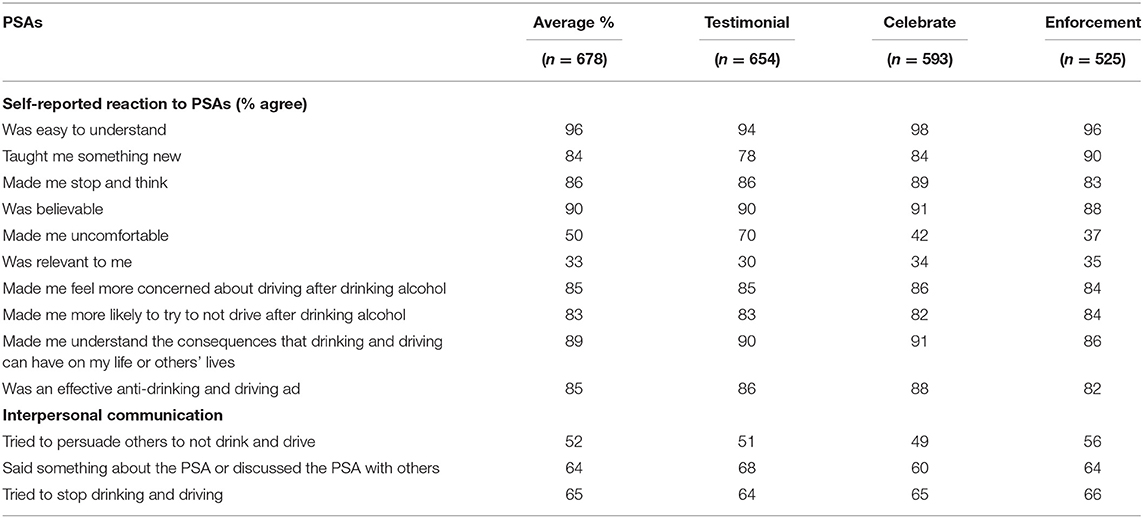
Table 3. Appraisal of campaign messages and actions taken as a result of campaign awareness in post-campaign period by PSA type.
Changes in Knowledge and Attitudes
There were significant differences in key measures of knowledge and attitudes about drink driving between pre- and post-campaign participants (see Table 4). After the campaign, there was a significant increase in the proportion of participants who agreed that it is difficult to know how much alcohol you can drink and still drive safely. A significantly greater proportion of post-campaign survey participants reported feeling unsafe about driving after drinking alcohol, compared with pre-campaign survey participants (68 vs. 59%). Likewise, after the campaign, participants showed significant improvement in several measures of knowledge around drinking and driving, compared with pre-campaign survey participants. Among post-campaign participants, 29% agreed that they were capable of determining when they have had too much to drink and drive, compared with 39% of pre-campaign participants. In addition, after the campaign, there was a significant reduction in the proportion of participants who agreed that people should be free to judge how much they can safely drink and drive (49 vs. 37%); and, a significant reduction in the proportion who agreed that having one or two alcoholic drinks does not make them more likely to crash (26 vs. 23%). Similar findings were observed in the studies done by Angle et al. (2009) and van Bueren et al. (2016).
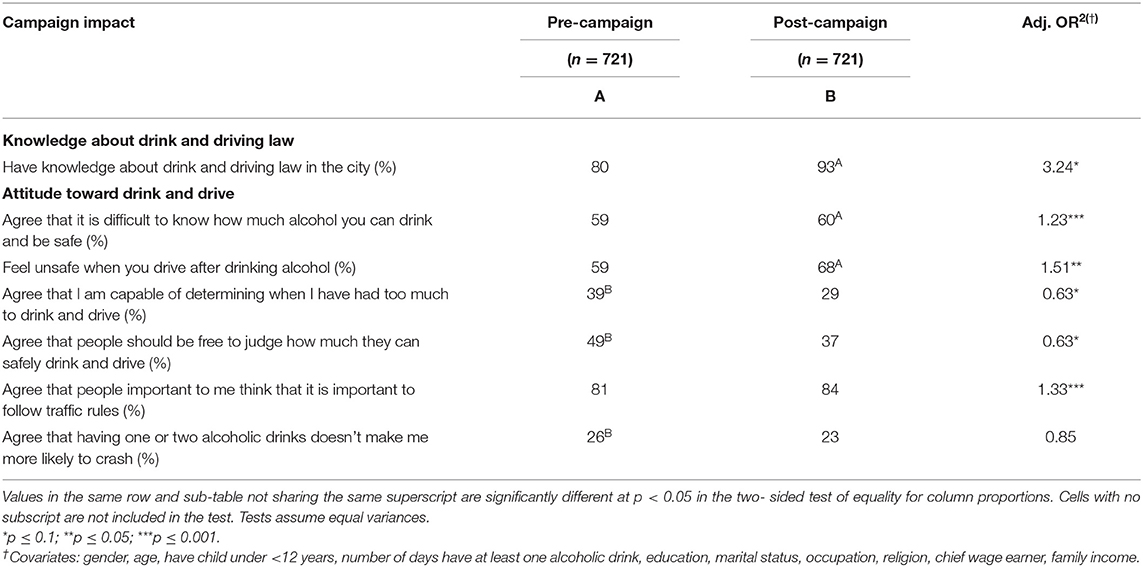
Table 4A. Campaign impact on knowledge and attitudes and support for government action, by pre-campaign and post-campaign period.
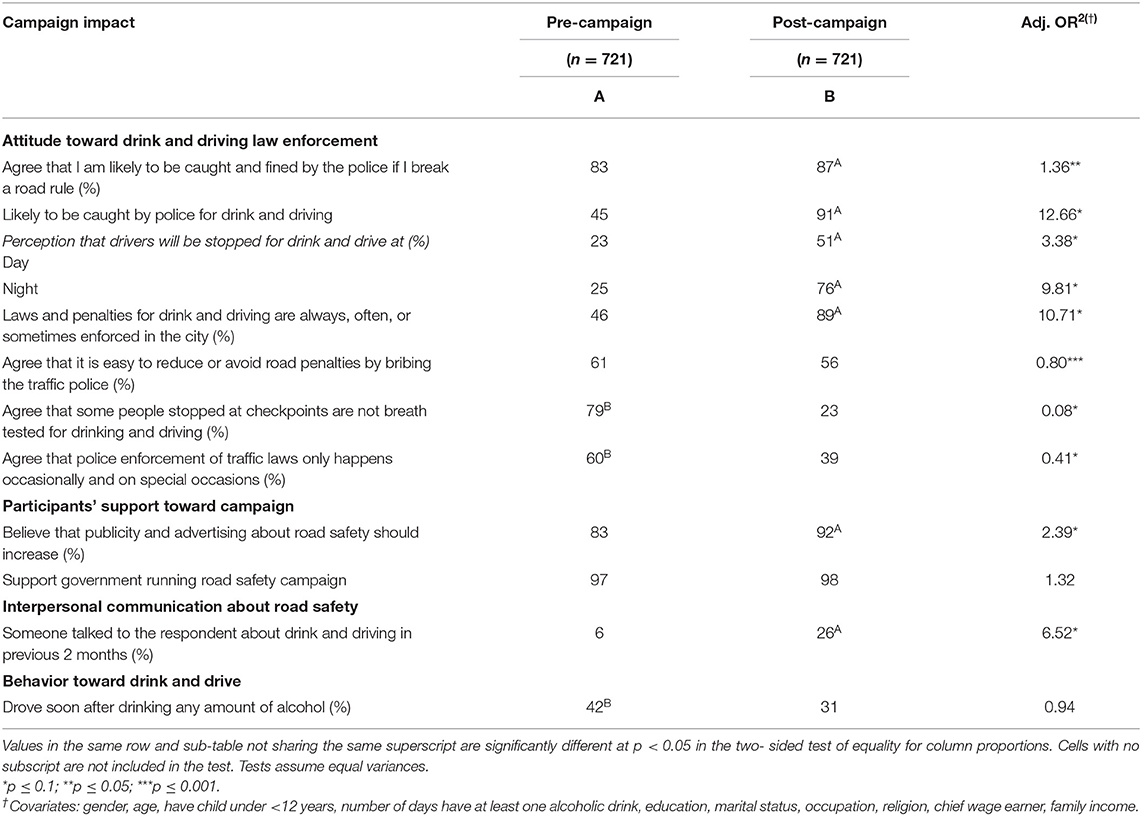
Table 4B. Campaign impact on risk perception, interpersonal communication, support for government action, and behavior, by pre-campaign and post-campaign period.
After the campaign, social norms related to road safety also showed a positive shift. Post-campaign survey participants were more likely to agree that people important to them think that it is important to follow traffic rules, compared with pre-campaign survey participants. There was also an increase in interpersonal communication. More than four times as many post-campaign survey participants said someone has spoken to them about drinking and driving in the previous 2 months, compared with pre-campaign survey participants (26 vs. 6%). Finally, following the campaign, there was a statistically significant increase in the proportion of participants who said that publicity and advertising about road safety should increase (83 vs. 92%).
Post-campaign survey participants demonstrated significantly greater levels of knowledge about road safety laws, compared with pre-campaign survey participants. After the campaign, 93% of participants post-campaign reported that they have knowledge about the drinking and driving laws in the city, compared with 80% of pre-campaign participants. There was also a significant increase following the campaign in agreement with beliefs that laws would be enforced. Post-campaign survey participants who recalled the campaign were significantly more likely to agree that a person is likely to be caught and fined by the police if they break a road rule (OR = 1.36, p < 0.05); that drivers would be stopped for drink driving, particularly at night (OR = 9.81, p < 0.1); and that the enforcement of laws and penalties for drink and driving in the city would occur (OR = 10.71, p < 0.1). Similarly, after the campaign, fewer participants agreed that it is easy to reduce or avoid road penalties by bribing the traffic police (OR = 0.80, p < 0.01); that some people stopped at checkpoints are not breath tested for drinking and driving (OR = 0.08, p < 0.1); and that police enforcement of traffic laws only happens occasionally and on special occasions (OR = 0.41, p < 0.1), compared with pre-campaign participants.
Following the campaign, self-reported risk behavior showed improvement as well. Post-campaign participants reported lower rates of driving soon after drinking any amount of alcohol, compared with pre-campaign participants, although differences were not significant (31 vs. 42%). Linkenbach and Perkins (2005) and van Bueren et al. (2016) had similar findings in their studies.
Discussion
This study is one of the first that aims to capture knowledge, attitudes, and practices around drinking and driving and its enforcement in Addis Ababa. The results show that the campaign performed as intended and had a positive impact on social norms and on drivers' knowledge and attitudes toward drinking and driving in Addis Ababa. In addition, this study has great significance as a campaign evaluation, demonstrating the value of the intervention in Addis Ababa.
Recall of the campaign was impressively high, with 97% of study participants recalling any of the three PSAs and 66% recalling all three. Recall of all three PSAs was higher among participants who were younger, had higher incomes, and who reported drinking alcohol. Our findings of high rates of recall suggest that the media outlets—television, radio, and outdoor—were effective at reaching the target audience. Despite a constantly expanding social media user base in Addis Ababa, the PSA had the highest recall for those participants who viewed it via television. This is consistent with previous findings of television being the most common source of information, and thus highest recall is reported through television (Angle et al., 2009; van Bueren et al., 2016).
This study showed positive changes in attitudes toward drink driving, and these were consistent with the campaign's intent. Post-campaign participants were over one and a half times more likely to report feeling unsafe about drinking and driving (OR = 1.51, p < 0.05) and nearly one-quarter times more likely to agree it is difficult to know how much alcohol you can drink and drive safely, compared with pre-campaign survey participants. These results indicate that the mass media campaign increased drivers' perceptions of the risks of drinking and driving. This campaign, as other effective campaigns, was successful in increasing risk perceptions, which encourages a shift in attitudes toward drink driving (Tay, 2002).
Social norms have a powerful influence on how people approach risky road behaviors. The results of this study in Addis Ababa suggest a positive change in social norms related to drinking and driving. After the campaign, participants were one and a third times more likely to report people important to them think it is important to follow traffic rules, compared with pre-campaign participants (OR = 1.33, p < 0.001). Increased interpersonal communication about risky behaviors is an important proxy for changes in social norms, and it is essential that a PSA generates interpersonal communication that is effective and causes behavioral change (Southwell and Yzer, 2007). We found that interpersonal communication about drinking and driving significantly increased after the campaign. Following the campaign, the proportion of survey participants who said someone had spoken to them about drinking and driving had more than quadrupled, compared with pre-campaign survey participants. Among campaign-aware participants, interpersonal communication was even higher, with participants having discussed drinking and driving with others and having tried to persuade others to not drink and drive.
After the campaign, participants showed significantly greater levels of support for and confidence in enforcement activities, as well as an increased perception of the risk of getting caught for drinking and driving. Findings from this study build on previous literature examining the impact of anti-drink-driving mass media campaigns on enforcement. Along with communicating about health harms and changing people's risk perceptions, campaigns and PSAs that showcase enforcement strategies as a means of message delivery have also been found to be effective in reducing crashes (Phillips et al., 2011; Alonso et al., 2015). This can also help increase support for enforcement and additional penalties for driving under the influence of alcohol (Agent et al., 2002). Linkenbach and Perkins (2005) found a campaign also affected attitudes toward impaired driving enforcement policy and generated support for policies to reduce impaired driving. Finally, this study, as have earlier studies, found that after the campaign the majority of post-campaign survey participants felt that they would be likely to be caught by the police if they were to drive after drinking (Angle et al., 2009).
In line with international best practice, this campaign was timed to coincide with widespread enforcement of drink driving laws by police in Addis Ababa. Prior to this initiative, police in Addis Ababa had not used breathalyzers or conducted routine drinking and driving screenings. Therefore, the visible police enforcement on the roads while the campaign was on the air is likely to have contributed to the changes in attitudes toward enforcement and toward the acceptability of drinking and driving. This is in line with previous studies (Stanojević et al., 2013; Esser et al., 2016) that found that strict enforcement made people fear being caught, resulting in desirable behavior change. Other studies concluded that a multi-pronged approach, such as the one used in Addis Ababa, was effective in changing behavior because it combined legal penalties for violations with communication campaigns (Anderson et al., 2009; World Health Organization, 2010; Cheng et al., 2011; Hoekstra and Wegman, 2011).
Participants in the post-campaign survey as compared to the pre-campaign were nearly two and a half times more likely to report increased support for publicity and advertising about road safety, suggesting that future campaigns on road safety risk factors may be equally well-received.
Finally, and perhaps most importantly, this study found that after the campaign there was improvement in self-reported risk behavior, which previous studies have also found (Tay, 2002). In the post-campaign survey, significantly fewer drivers reported that they drove soon after drinking any amount of alcohol (31% post-campaign vs. 42% pre-campaign). Given the measured change in attitudes and norms, and if both communication and enforcement efforts continue, it is reasonable to be optimistic that dangerous drinking and driving behavior will continue to decrease in Addis Ababa.
Study Limitations
There are several limitations to the study. First, the study did not measure frequency of exposure to the campaign. To ensure that a media campaign has a strong impact, a sufficient level of media exposure is needed (Linkenbach and Perkins, 2005). Estimating the relationship between the frequency of exposure to the campaign and behavior change can inform the minimum level of exposure required for impact, which can be useful for developing cost-effective campaigns, especially in low-income countries with limited resources, and thus future studies can do so. Second, the study relied on many self-reported measures, including drinking, and driving practices; the reliability and validity of these measures is unknown. An assessment of blood alcohol concentration (BAC) in a randomly selected sample could potentially have yielded more reliable and valid results. That said, we used preexisting measures known to be reliable where possible. Pilot testing was done to ensure that the questions worked as intended. The questionnaire design, including consideration of order effects, sought to address any potential biases from self-reports. Third, there exist limitations in the study's design by which participants were not randomly assigned to campaign exposure; randomly assigning participants to campaign exposure and no exposure would allow for establishing causal effects of the campaign on knowledge, attitudes, and behavior, but this is generally impractical for a mass media campaign in a defined geographical area such as a city. Fourth, a limitation is that the results cannot be generalized to the whole of Ethiopia, since they are applied to a very specific area; however, this makes them especially useful for future interventions and communication campaigns in Addis Ababa. Finally, the study does not examine the campaign's impact on the prevalence of drink driving-related road traffic crashes or its long-term effects in Addis Ababa. To address this limitation, in future studies, it could be useful to compare self-reported results with data on road traffic crashes. In addition, follow-up surveys would be useful to measure whether the campaign's effects are maintained over time. Since governments are advised to conduct a series of campaigns, based on evidence that single campaigns have a limited long-term effect, a survey before the next campaign would provide information on long-term impacts, as well as serving as a baseline to measure the impact of later campaigns.
Conclusion
Previous studies in high-income countries have found that mass media campaigns can play an important role in changing drink driving behaviors (Dejong and Charles, 1995; Linkenbach and Perkins, 2005; Geleta et al., 2020). Findings from this study reveal anti-drink-driving campaigns can be an effective public health tool to increase knowledge, change attitudes, and reduce risky road behaviors around drinking and driving in Addis Ababa. The objective of the campaign in Addis Ababa was to make drivers aware of the dire consequences of drinking and driving, and in turn change their related knowledge, attitudes, and behaviors. The campaign achieved gains in knowledge and improved attitudes toward drink driving, and, importantly, reduced drinking, and driving behavior, which could help to curb road traffic crashes and related deaths and injuries in Addis Ababa. Findings of this study are useful for local government and public health officials in understanding the efficacy of the campaign and messages for future mass media campaigns in Addis Ababa.
This study offers some of the first evidence that a campaign targeting drinking and driving, paired with enhanced enforcement of drinking and driving laws, can be effective, not just in high-income countries, but in low- and middle-income countries as well. Almaz et al. (2014), Mekonen (2016), Bekele and Sima (2019), Kebede et al. (2019), and Geleta et al. (2020) suggested that multiple intervention programs that include public awareness, enforcement of drink driving laws, and other road safety laws have proven effective in controlling alcohol-impaired driving and alcohol-related crashes. Mass media campaigns on risky road behavior such as drink driving should be sustainably funded and scientifically developed to promote lasting behavior change.
Data Availability Statement
The raw data supporting the conclusions of this article will be made available by the authors, to other researchers on request, following publication. The researchers will sign a contract with Vital Strategies on data use.
Ethics Statement
Ethical review and approval was not required for the study on human participants in accordance with the local legislation and institutional requirements. Written informed consent for participation was not required for this study in accordance with the national legislation and the institutional requirements.
Author Contributions
NSN: conception, study design and direction of data analysis, data interpretation, literature review, and writing. KS: help in writing and overall technical assistance for the campaign and evaluation. IM and SM: review and overall guidance of this evaluation. TA: conduct of the analysis. SK: strategic planning of mass media and implication of evaluation findings. AN: coordination with stakeholders. NK: review of analysis and help in writing. NM: conception, study design and direction of data analysis, data interpretation, and help in writing the paper. All authors: contributed to manuscript revision and read and approved the submitted version.
Funding
As a part of the 5-year Bloomberg Philanthropies Initiative for Global Road Safety, Vital Strategies was supported by a grant from Bloomberg Philanthropes for the impact evaluation and analysis. However, Bloomberg Philanthropies was not involved in any aspect of the evaluation study or the writing of this manuscript. The authors have not received any additional remuneration to write this article.
Conflict of Interest
The authors declare that the research was conducted in the absence of any commercial or financial relationships that could be construed as a potential conflict of interest.
Acknowledgments
The authors gratefully acknowledge Bloomberg Philanthropies for their generous support of this project, as well as the Addis Ababa staff and international partners of the Bloomberg Philanthropies Initiative for Global Road Safety, Vital Strategies communication consultant, Tsion Kiros, and the Addis Ababa Traffic Management Agency, which funded the airtime for the campaign. The authors would also like to acknowledge Julia Berenson for editorial support and Meena Maharjan for her support in writing the paper.
Supplementary Material
The Supplementary Material for this article can be found online at: https://www.frontiersin.org/articles/10.3389/frsc.2020.563350/full#supplementary-material
References
Agent, K. R., Green, E. R., and Langley, R. E. (2002). Evaluation of Kentucky's You Drink and Drive. You Lose. Kentucky Transportation Center Research Report, 244. Available online at: https://uknowledge.uky.edu/ktc_researchreports/244 (accessed January 10, 2020).
Almaz, B., Cherie, A., and Bayray, A. (2014). Assessment of road traffic accidents among children in addis ababa city, Ethiopia; a retrospective record. J. Med. Sci. Technol. 3, 25–36.
Alonso, F., Pastor, J. C., Montoro, L., and Esteban, C. (2015). Driving under the influence of alcohol: frequency, reasons, perceived risk and punishment. Subst. Abuse Treat. Prev. Policy 10:11. doi: 10.1186/s13011-015-0007-4
Anderson, P., Chisholm, D., and Fuhr, D. C. (2009). Effectiveness and cost-effectiveness of policies and programmes to reduce the harm caused by alcohol. Lancet 373, 2234–2246. doi: 10.1016/S0140-6736(09)60744-3
Angle, H., Kirwan, S., Buckley, K., and Goddard, E. (2009). THINK! Road Safety Campaign Evaluation. Post evaluation of the ‘Personal Consequences’ drink drive campaign report. British Market Research Bureau (BMRB) Social Research.
Anteneh, A., and Endris, B. S. (2020). Injury related adult deaths in Addis Ababa, Ethiopia: analysis of data from verbal autopsy. BMC Public Health 20:926. doi: 10.1186/s12889-020-08944-7
Bachani, A. M., Risko, C. B., Gnim, C., Coelho, S., and Hyder, A. A. (2017). Knowledge, attitudes, and practices around drinking and driving in Cambodia: 2010–2012. Public Health 144, S32–S38. doi: 10.1016/j.puhe.2016.12.012
Bekele, T. G., and Sima, T. H. (2019). Road Traffic Accident Cause and Effect on Socio Economy of Addis Ababa City. Faculty/Department: Research and plan, Addis Ababa, Ethiopia.
Carvajal, F., and Lerma-Cabrera, J. M. (2015). “Alcohol consumption among adolescents—implications for public health,” ins Top Public Health, ed D. Claborn (Intech), 51–76. doi: 10.5772/58930
Census of Ethiopia (2007). Population and Housing Census of Ethiopia, Administrative Report. Central Statistical Authority Addis Ababa.
Cheng, H., Lee, N., and Kotler, P. (2011). Social Marketing for Public Health: Global Trends and Success Stories. Sudbury, MA: Jones & Bartlett Learning.
Decker, M. D., Graitcer, P. L., and Schaffner, W. (1988). Reduction in motor vehicle fatalities associated with an increase in the minimum drinking age. JAMA 260, 3604–3610. doi: 10.1001/jama.1988.03410240074035
Dejong, W., and Charles, K. A. (1995). A review of national television PSA campaigns for preventing alcohol-impaired driving, 1987–1992. J. Public. Health. Policy 16:59–80.
Elder, R. W., Shults, R. A., Sleet, D. A., Nichols, J. L., Thompson, R. S., Rajab, W., et al. (2004). Effectiveness of mass media campaigns for reducing drinking and driving and alcohol-involved crashes: a systematic review. Am. J. Prev. Med. 27, 57–65. doi: 10.1016/j.amepre.2004.03.002
Elliott, B. (1993). Road Safety Mass Media Campaigns: A Meta Analysis. Vol. CR 118. Canberra, ACT: Federal Office of Road Safety.
Elvik, R., Vaa, T., Hoye, A., and Sorensen, M. (2004). “Factors contributing to road accidents,” in The Handbook of Road Safety Measures, eds R. Elvik, A. Hoye, T. Vaa, and M. Sorensen (Oxford: Emerald Group Publishing Limited), 29–79.
Esser, M. B., Wadhwaniya, S., Gupta, S., Tetali, S., Gururaj, G., Stevens, K. A., and Hyder, A. A. (2016). Characteristics associated with alcohol consumption among emergency department patients presenting with road traffic injuries in Hyderabad, India. Injury 47, 160–165. doi: 10.1016/j.injury.2015.07.022
Geleta, D. K., Adem, H. A., Kumsa, F. A., Demena, M., and Gobena, T. (2020). Road traffic accidents fatality and associated factors in Southwest Shoa, central Ethiopia. East Afr. J. Health Biomed. Sci. 4, 35–46. Available online at: http://ejol.aau.edu.et/index.php/EAJHBS/article/view/1810/1260
Hoekstra, T., and Wegman, F. (2011). Improving the effectiveness of road safety campaigns: current and new practices. IATSS Res. 34, 80–86. doi: 10.1016/j.iatssr.2011.01.003
John's Hopkins University, 2019. “Monitoring and Evaluation Baseline report, Addis Ababa,” in Bloomberg Initiative for Global Road safety (BIGRS) 2015-2019. Unpublished report.
Kebede, A., Beyene, T., and Geremew, H. (2019). Road Traffic Accident Related Fatalities in Addis Ababa City, Addis Ababa, Ethiopia: An Analysis of Police Report 2013/14. ECRONICON.
Kenkel, D. S. (1993). Drinking, driving, and deterrence: the effectiveness and social costs of alternative policies. J. Law Econ. 36, 877–913. doi: 10.1086/467301
Lastovicka, J. L., Murry, J. P. Jr., and Joachimsthaler, E. A. (1990). Evaluating the measurement validity of lifestyle typologies with qualitative measures and multiplicative factoring. J. Market. Res. 27, 11–23. doi: 10.1177/002224379002700102
Linkenbach, J., and Perkins, H. W. (2005). Montana's MOST of Us Don't Drink and Drive Campaign: A Social Norms Strategy to Reduce Impaired Driving Among 21-34-Year-Olds. Available online at: https://www.bieringlaw.com/wp-content/uploads/sites/1304/2015/09/SocialNorms.pdf (accessed July 1, 2020).
Martí-Belda, B., Pastor, J. C., Montoro, L., Bos,ó, P., and Roca, J. (2019). Persistent traffic offenders. Alcohol consumption and personality as predictors of driving disqualification. Eur. J. Psychol. Appl. Legal Context 11, 81–92. doi: 10.5093/ejpalc2019a3
Mekonen, E. K. (2016). The economic effect of road traffic accidents in Ethiopia: evidences from Addis Ababa city. ITIHAS J. Indian Manag. 6, 11–21.
Mruk (2007). Road Safety Drink-Drive 2006 Campaign Evaluation. Available online at: www.scotland.gov.uk/socialresearch (accessed March 28, 2019).
Murry, J. P., Stam, A., and Lastovicka, J. L. (1993). Evaluating an anti-drinking and driving advertising campaign with a sample survey and time series intervention analysis. J. Am. Stat. Assoc. 88, 50–56. doi: 10.1080/01621459.1993.10594288
Noar, S. M. (2006). A 10-year retrospective of research in health mass media campaigns: where do we go from here? J. Health Commun. 11, 21–42. doi: 10.1080/10810730500461059
Pan American Health Organization and World Health Organization (2018). Drinking and Driving. Pan American Health Organization and World Health Organization. Available online at: https://www.paho.org/hq/index.php?option=com_docman&view=download&category_slug=factsheets-5288&alias=46059-drinking-driving-2018-059&Itemid=270&lang=en (accessed July 1, 2020).
Phillips, R. O., Ulleberg, P., and Vaa, T. (2011). Meta-analysis of the effect of road safety campaigns on accidents. Accid. Anal. Prev. 43, 1204–1218. doi: 10.1016/j.aap.2011.01.002
Redman, S., Spencer, E. A., and Sanson-Fisher, R. W. (1990). The role of mass media in changing health-related behaviour: a critical appraisal of two models. Health Promot. Int. 5, 85–101. doi: 10.1093/heapro/5.1.85
Southwell, B. G., and Yzer, M. C. (2007). The roles of interpersonal communication in mass media campaigns. Ann. Int. Commun. Assoc. 31, 420–462. doi: 10.1080/23808985.2007.11679072
Stanojević, P., Jovanović, D., and Lajunen, T. (2013). Influence of traffic enforcement on the attitudes and behavior of drivers. Accid. Anal. Prev. 52, 29–38. doi: 10.1016/j.aap.2012.12.019
Stewart, K., Silcock, D., and Wegman, F. (2012). Reducing drink driving in low- and middle-income countries: challenges and opportunities. Traffic Inj. Prev. 13, 93–95. doi: 10.1080/15389588.2011.634464
Tay, R. (2002). Exploring the effects of a road safety advertising campaign on the perceptions and intentions of the target and nontarget audiences to drink and drive. Traffic Inj. Prev. 3, 195–200. doi: 10.1080/15389580213651
Ulleberg, P., Vaa, T., Ausserer, K., Carstensen, G., Forward, S., Krol, B., et al. (2009). Road User Model and Persuasion Technique: Final Version. Uden navn, No. D 1.4 Available online at: http://www.cast-eu.org/docs/CAST_WP1_Deliverable%201.4.pdf (accessed March 28, 2019).
Useche, S., Serge, A., Alonso, F., and Esteban, C. (2017). Alcohol consumption, smoking, job stress and road safety in professional drivers. J. Addict. Res. Ther. 8:1000321. doi: 10.4172/2155-6105.1000321
van Bueren, D., Picton, L., Grainger, A., and Chow, W. (2016). Road Safety Commission WA Drink Driving Full Campaign Evaluation 2016. TNS and Road Safety Commission. Available online at: https://www.rsc.wa.gov.au/RSC/media/Documents/Resources/Publications/Justover-Growup-Campaign-Evaluation.pdf
Wakefield, M. A., Loken, B., and Hornik, R. C. (2010). Use of mass media campaigns to change health behaviour. Lancet 376, 1261–1271. doi: 10.1016/S0140-6736(10)60809-4
World Health Organization (2010). Global Strategy to Reduce the Harmful Use of Alcohol. World Health Organization. Available online at: https://apps.who.int/iris/bitstream/handle/10665/44395/9789241599931_eng.pdf;jsessionid=367D7751C80AB889CB96B37C9C5626CB?sequence=1 (accessed March 29, 2019).
World Health Organization (2018). Global Status Report On Road Safety 2018. World Health Organization. Available online at: https://www.who.int/violence_injury_prevention/road_safety_status/2018/English-Summary-GSRRS2018.pdf (accessed July 1, 2020).
Yadav, A. K., Rai, B. K., Niraula, S. R., Yadav, A., Bhandari, R., and Shrivastav, V. (2019). Identification of alcohol problem among long route bus drivers and staffs of Dharan, eastern Nepal: assessing from the CAGE and DSM-IV tools. J. Fam. Med. Prim. Care 8, 853–59. doi: 10.4103/jfmpc.jfmpc_301_17
Young, B., Lewis, S., Katikireddi, S. V., Bauld, L., Stead, M., Angus, K., et al. (2018). Effectiveness of mass media campaigns to reduce alcohol consumption and harm: a systematic review. Alcohol Alcoholism 53, 302–316. doi: 10.1093/alcalc/agx094
Keywords: mass media campaigns, evaluation, behavioral intentions, road safety, perceived risks, attitudes, enforcement, drink driving
Citation: Negi NS, Schmidt K, Morozova I, Addis T, Kidane S, Nigus A, Kumar N, Mullin S and Murukutla N (2020) Effectiveness of a Drinking and Driving Campaign on Knowledge, Attitudes, and Behavior Among Drivers in Addis Ababa. Front. Sustain. Cities 2:563350. doi: 10.3389/frsc.2020.563350
Received: 18 May 2020; Accepted: 14 September 2020;
Published: 23 November 2020.
Edited by:
Krzysztof Goniewicz, Military University of Aviation, PolandReviewed by:
Japheths Onyango Ogendi, Maseno University, KenyaFrancisco Alonso, University of Valencia, Spain
Copyright © 2020 Negi, Schmidt, Morozova, Addis, Kidane, Nigus, Kumar, Mullin and Murukutla. This is an open-access article distributed under the terms of the Creative Commons Attribution License (CC BY). The use, distribution or reproduction in other forums is permitted, provided the original author(s) and the copyright owner(s) are credited and that the original publication in this journal is cited, in accordance with accepted academic practice. No use, distribution or reproduction is permitted which does not comply with these terms.
*Correspondence: Nalin Singh Negi, nnegi@vitalstrategies.org
 Nalin Singh Negi
Nalin Singh Negi Karen Schmidt
Karen Schmidt Irina Morozova
Irina Morozova Tigist Addis2
Tigist Addis2  Asmeret Nigus
Asmeret Nigus